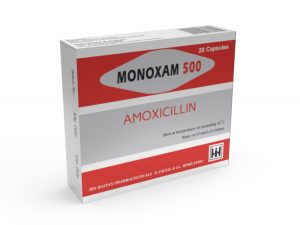استطباب: Penicillin Antibiotic
Packing :100 ml.
Form : Dry Suspension
Theraputic Categories : Anti- infectives
Indications : Penicillin Antibiotic
Composition :Amoxicillin ( trihydrate ) 250 mg./ 5 ml.
Packing :100 cap.
Form : Capsules
Theraputic Categories : Anti- infectives
Indications : Penicillin Antibiotic
Composition :Amoxicillin ( trihydrate ) 500 mg.
Packing :20 tab.
Form : Tablets
Theraputic Categories : Anti- infectives
Indications : Penicillin Antibiotic
Composition :Penicillin V potassium 1000000 I.U.
Packing :60 ml.
Form : Dry Suspension
Theraputic Categories : Pediatric Drugs
Indications : Penicillin Antibiotic
Composition :Ampicillin ( Trihydrate ) 125 mg. + Cloxacillin ( Na. H2O ) 125 mg. / 5 ml.
Packing :100 ml.
Form : Dry Suspension
Theraputic Categories : Pediatric Drugs
Indications : Penicillin Antibiotic
Composition :Ampicillin 250 mg. / 5 ml.

Packing :20 cap.
Form : Capsules
Theraputic Categories : Anti- infectives
Indications : Penicillin Antibiotic
Composition :Amoxicillin ( Trihydrate ) 250 mg.+ Flucloxacillin ( Na.H2O ) 250 mg.
Composition:
Each capsule contains :
– Amoxicillin (as trihydrate) 250 mg.
– Flucloxacillin (as sodium salt) 250 mg.
Each 5 ml oral suspension contains the equivalent of:
-Amoxicillin (as trihydrate) 125 mg.
-Flucloxacillin (as sodium salt) 125 mg.
Pharmacological Properties:
The two components of Amoxam ( amoxicillin and flucloxacillin) generally exhibit an additive effect against sensitive bacteria and bacteria that are sensitive to amoxicillin or to flucloxacillin remain sensitive to the combination, showing that antagonism does not occur when the two components are combined. Amoxam exhibits synergistic bactericidal activity against some ampicillin-resistant organisms.
Amoxam exhibits bactericidal activity against a wide range of Gram-positive and Gram-negative bacteria. The following are among the more commonly encountered sensitive organisms:
Gram-positive bacteria: Streptococcus (pyogenes, faecalis, viridans), Dip. Pneumoniae, Staphylococcus aureus (penicillin sensitive, penicillinase producing), Corynebacterium species, clostridium species, Bacillus anthracis.
Gram-negative bacteria: Neisseria (gonorrhoeae, meningitides), Haemophilus influenzae, Escherichia coli, Salmonella species, Proteus mirabilis, Bordetella pertussis, Shigella species, Brucella species.
Indications:
Amoxam is indicated for the treatment of a wide range of bacterial infections, caused by susceptible organisms; in particular infections of mixed origin where penicillin-resistant staphylococci may be implicated or where the causative organism is unknown.
Typical indications include:
– Acute and chronic bronchitis – Gynaecological infections
– Pneumonia – Pelvic inflammatory disease
– Ear, nose and throat infections – Urinary tract infections
– Skin and soft tissue infections.
Contraindications:
Amoxam should not be given to those subjects hypersensitive to penicillin and should not be given to neonates.
Side-Effects and Special Precautions:
Allergic reactions may occur, and these are normally mild in nature, presenting as a pruritic skin rash, erythematous skin reaction or urticaria. In this event withdrawal of Amoxam and administration of an antihistamine will suffice in most cases. Should a serious anaphylactic reaction occur, the drug should be discontinued and the patient treated with usual agents: (adrenaline, corticosteroids and antihistamines).
The use of this antibiotic may lead to the appearance of resistant strains of organisms and sensitivity testing should, therefore, be carried out whatever possible, to ensure the appropriateness of the therapy. Hepatitis and cholestatic jaundice have been reported rarely.
Pregnancy: category B:
Amoxam should be used during pregnancy only if clearly needed, and under medical advice.
Nursing Mothers:
Caution should be exercised to nursing woman.
Overdose:
As with all penicillins, oral administration can cause gastro-intestinal symptoms such as transient diarrhoea, nausea and colic which are dose related and a result of local irritation not toxicity.
Dosage and Administration:
– Adults: one 500 mg capsule three times a day.
– Children 2-12 years: 5 ml of the reconstituted suspension ( containing 250 mg Amoxam ) three times a day.
– Children under 2 years: 2.5 ml of reconstituted suspension ( containing 125 mg Amoxam) three times a day.
In severe infections this dosage may safely be increased.
To ensure maximal absorption Amoxam should be given in the fasting state, i.e. Approximately 1 hour before a meal.
Packing:
Box containing 20 capsules.
Glass bottle containing powder for preparation of 60 ml or 100 ml of 250/5 ml suspension.
Storage:
– containers should be kept tightly closed in a cool (below 25° C), dry place.
– Once dispensed Amoxam suspension must be used within 7 days if stored in a cool place (below 25° C) or 14 days if stored in a refrigerator.
Packing :60 ml.
Form : Dry Suspension
Theraputic Categories : Pediatric Drugs
Indications : Penicillin Antibiotic
Composition :Amoxicillin (Trihydrate ) 125 mg. + Flucloxacillin ( Na.H2O ) 125 mg./5ml.
Composition:
Each capsule contains :
– Amoxicillin (as trihydrate) 250 mg.
– Flucloxacillin (as sodium salt) 250 mg.
Each 5 ml oral suspension contains the equivalent of:
-Amoxicillin (as trihydrate) 125 mg.
-Flucloxacillin (as sodium salt) 125 mg.
Pharmacological Properties:
The two components of Amoxam ( amoxicillin and flucloxacillin) generally exhibit an additive effect against sensitive bacteria and bacteria that are sensitive to amoxicillin or to flucloxacillin remain sensitive to the combination, showing that antagonism does not occur when the two components are combined. Amoxam exhibits synergistic bactericidal activity against some ampicillin-resistant organisms.
Amoxam exhibits bactericidal activity against a wide range of Gram-positive and Gram-negative bacteria. The following are among the more commonly encountered sensitive organisms:
Gram-positive bacteria: Streptococcus (pyogenes, faecalis, viridans), Dip. Pneumoniae, Staphylococcus aureus (penicillin sensitive, penicillinase producing), Corynebacterium species, clostridium species, Bacillus anthracis.
Gram-negative bacteria: Neisseria (gonorrhoeae, meningitides), Haemophilus influenzae, Escherichia coli, Salmonella species, Proteus mirabilis, Bordetella pertussis, Shigella species, Brucella species.
Indications:
Amoxam is indicated for the treatment of a wide range of bacterial infections, caused by susceptible organisms; in particular infections of mixed origin where penicillin-resistant staphylococci may be implicated or where the causative organism is unknown.
Typical indications include:
– Acute and chronic bronchitis – Gynaecological infections
– Pneumonia – Pelvic inflammatory disease
– Ear, nose and throat infections – Urinary tract infections
– Skin and soft tissue infections.
Contraindications:
Amoxam should not be given to those subjects hypersensitive to penicillin and should not be given to neonates.
Side-Effects and Special Precautions:
Allergic reactions may occur, and these are normally mild in nature, presenting as a pruritic skin rash, erythematous skin reaction or urticaria. In this event withdrawal of Amoxam and administration of an antihistamine will suffice in most cases. Should a serious anaphylactic reaction occur, the drug should be discontinued and the patient treated with usual agents: (adrenaline, corticosteroids and antihistamines).
The use of this antibiotic may lead to the appearance of resistant strains of organisms and sensitivity testing should, therefore, be carried out whatever possible, to ensure the appropriateness of the therapy. Hepatitis and cholestatic jaundice have been reported rarely.
Pregnancy: category B:
Amoxam should be used during pregnancy only if clearly needed, and under medical advice.
Nursing Mothers:
Caution should be exercised to nursing woman.
Overdose:
As with all penicillins, oral administration can cause gastro-intestinal symptoms such as transient diarrhoea, nausea and colic which are dose related and a result of local irritation not toxicity.
Dosage and Administration:
– Adults: one 500 mg capsule three times a day.
– Children 2-12 years: 5 ml of the reconstituted suspension ( containing 250 mg Amoxam ) three times a day.
– Children under 2 years: 2.5 ml of reconstituted suspension ( containing 125 mg Amoxam) three times a day.
In severe infections this dosage may safely be increased.
To ensure maximal absorption Amoxam should be given in the fasting state, i.e. Approximately 1 hour before a meal.
Packing:
Box containing 20 capsules.
Glass bottle containing powder for preparation of 60 ml or 100 ml of 250/5 ml suspension.
Storage:
– containers should be kept tightly closed in a cool (below 25° C), dry place.
– Once dispensed Amoxam suspension must be used within 7 days if stored in a cool place (below 25° C) or 14 days if stored in a refrigerator.













